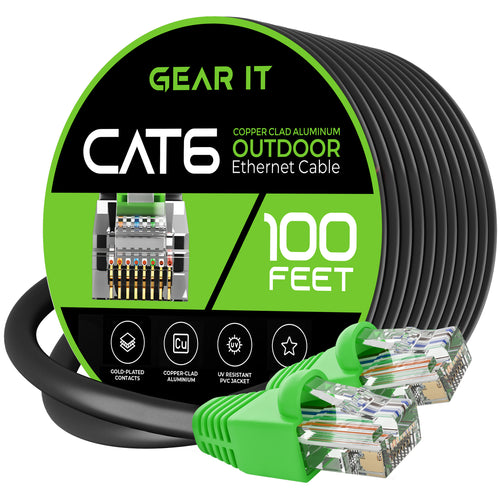You are probably used to using ethernet cables to connect devices inside your home or office. However, you may be less aware of applications that require outdoor ethernet cable. This guide covers some situations where you might need to use ethernet cables outdoors.
Applications That Require Outdoor Ethernet Cable
Outdoor ethernet cabling can be useful in a variety of situations:
-
• Outdoor Wi-Fi access points
-
• Outdoor IP-based security cameras
-
• Connections for two or more structures
You may choose to install outdoor cables in open-air runs or bury them underground, depending on the environment. Whichever installation method you choose, you need a specific type of cable.
The Difference Between Indoor and Outdoor Ethernet Cable
The primary difference between indoor and outdoor cable is the outer jacket of the cable. Indoor cables have jackets made from a thinner, more flexible material so that you can more easily run them through walls, ducts, and ceilings.
Outdoor cables have a jacket made from thicker plastic to withstand the harsh weather conditions of an outdoor environment. You can also run outdoor cables for longer distances than indoor cables.
The three main jacket types used with an outdoor ethernet cable are plenum, PVC, and direct burial. Plenum features extreme resistance to water and weather, and you can also use it in indoor spaces that have enough air circulation, such as dropped ceilings and raised floors.
PVC jackets resist harsh weather but are not fire-resistant. Because these cables release toxic smoke if they catch fire, they are not usually used inside buildings.
Direct burial jackets are the most durable. Cables with direct burial jackets are specifically for use in harsh conditions, such as extreme heat or cold.

Reasons To Use Outdoor Ethernet Cable Instead of Indoor Cable With a Conduit
Because indoor cabling is less expensive and some people do not want to install two types of cable, they may attempt to use indoor ethernet cables with protection from a conduit instead of outdoor cabling. However, this is not an ideal solution.
Outdoor conduits do not provide complete protection against water and weather, which can lead to damaged cables. Additionally, it may cost more money to purchase the materials for the conduit than it would cost to purchase an outdoor cable that you can install without the need for a conduit.
Though burying an outdoor cable provides additional protection from the weather and keeps it out of the way, outdoor cables are weather and UV-light resistant even when exposed to the air, which makes them ideal for above-ground connections, such as to security cameras.
Indoor cables are vulnerable to both sunlight and water and may fail if exposed to either. For maximum protection, you may want to install outdoor cables with a protective conduit.

Where To Buy Outdoor Ethernet Cable
Gear It carries a wide selection of outdoor ethernet cable. We focus on providing customers with consumer electronic accessories that keep their devices connected. Our years of service have made us the top brand in cable solutions. Visit our outdoor ethernet collection to find out more or make a purchase.





















































